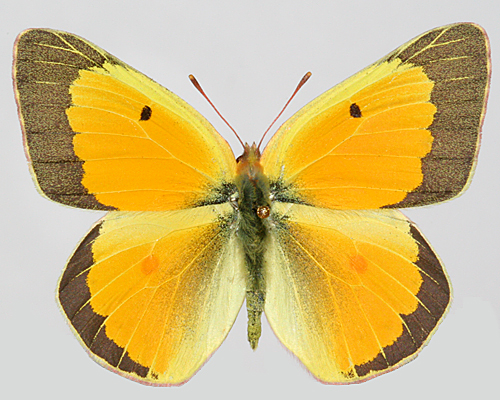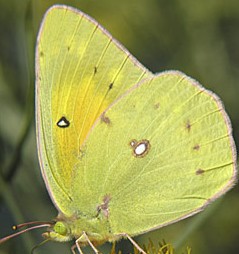 Alfalfa butterflies, also called orange sulphurs, are one of the most widespread butterflies in the US occurring coast to coast except in Florida. They can be found in a wide variety of open spaces such as meadows, vacant lots, roadsides and especially alfalfa fields. Both males and females have a wing span of 1 5/8 to 2 3/8 inches and bright gold-orange wings marked with a black border. The border of the females, however, is broken by yellow splotches. The ventral side of both genders is orange, yellow, or greenish-yellow. Alfalfas are difficult to distinguish from the common sulphur which is lemon yellow with similar markings.
Alfalfa butterflies, also called orange sulphurs, are one of the most widespread butterflies in the US occurring coast to coast except in Florida. They can be found in a wide variety of open spaces such as meadows, vacant lots, roadsides and especially alfalfa fields. Both males and females have a wing span of 1 5/8 to 2 3/8 inches and bright gold-orange wings marked with a black border. The border of the females, however, is broken by yellow splotches. The ventral side of both genders is orange, yellow, or greenish-yellow. Alfalfas are difficult to distinguish from the common sulphur which is lemon yellow with similar markings.
 In spring alfalfas emerge from their chrysalis in which they over wintered and males begin patrolling for females who choose their mate by a combination of chemical and visual stimuli. After mating the females deposit their whitish, pitcher-shaped eggs singly on top or bottom of host plant leaves. Grass green caterpillars with white longitudinal stripes and tiny
In spring alfalfas emerge from their chrysalis in which they over wintered and males begin patrolling for females who choose their mate by a combination of chemical and visual stimuli. After mating the females deposit their whitish, pitcher-shaped eggs singly on top or bottom of host plant leaves. Grass green caterpillars with white longitudinal stripes and tiny  white hairs emerge and begin feeding, eating one half of the leaf from stem to tip and then the other. After feeding the caterpillars pupate forming a green chrysalis with black and yellow dashes.
white hairs emerge and begin feeding, eating one half of the leaf from stem to tip and then the other. After feeding the caterpillars pupate forming a green chrysalis with black and yellow dashes.
As the common name implies, the favorite host plan is alfalfa (Medicago sativa), but white clover (Trifolium repens) and sweet clover (Melilotus officinalis) are also popular. To attract the adults to the garden plant purple coneflower (Echinacea purpurea), peppermint (Mentha piperita), hairy sunflower (Helianthus hirsutus), goldenrod (Solidago spp.), and asters. Adults also nectar on Queen Anne’s lace (Daucus carota) and dandelions .